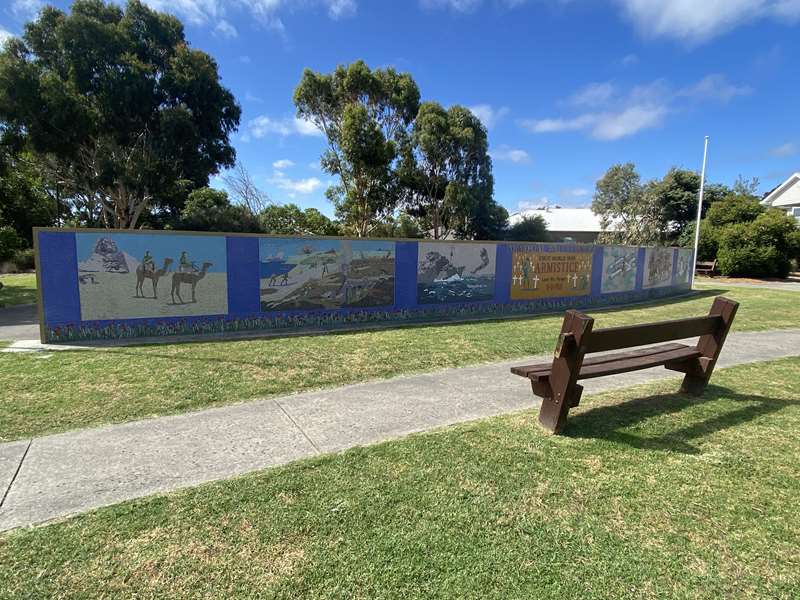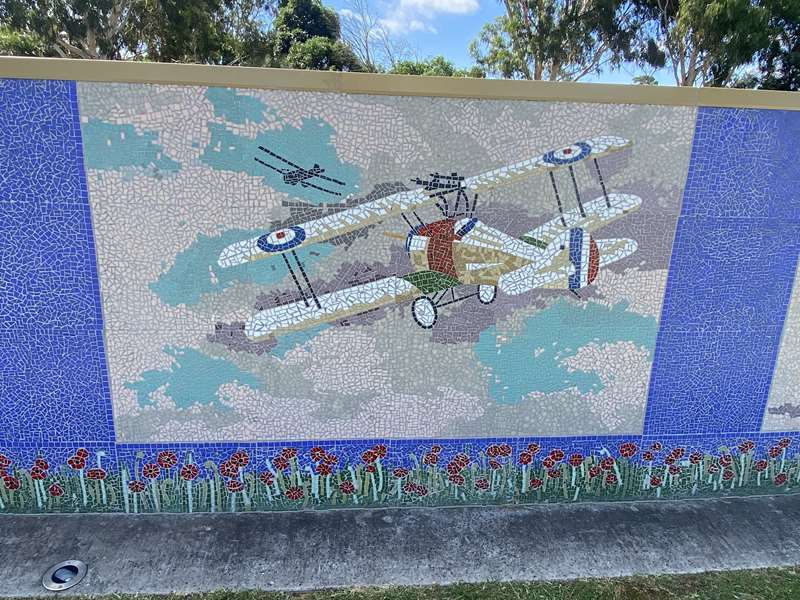Grantville Armistice Mural


The Grantville Armistice Mural commemorates the brave Army, Navy, Air Force and Nursing personnel who helped in the defence of our Nation during the First World War from 1914 to 1918.
An initiative of the Bass Valley Friends of the RSL, the mural commemorates the Centenary of the 1918 Armistice.
The mural contains images and information from the archives of the Australian War Memorial in Canberra. The project was funded by the Department of Veteran Affairs and the Bendigo Community Bank.
The Armistice Mural took six months to create, was designed and created by Janice Orchard and constructed with the help of volunteer members of the community. The mural is made of 86,750 individual vitreous glass tiles and took a total of 4,552 man hours to create.
Panel 1 - The Imperial Camel Corp
The Imperial Camel Corps Brigade (ICCB) was a camel-mounted infantry brigade that the British Empire raised in December 1916 during the First World War for service in the Middle East. With a brigade of four battalions, (Great Britain, New Zealand and two from Australia) the ICCB became part of the Egyptian Expeditionary Force (EEF). It fought in several battles and engagements including the Senussi Campaign, the Arab Revolt, the Battle of Rafa, the Battle of Beersheba, the Third Battle of Gaza and at the Battle of Mughar Ridge, before crossing the Sinai and entering into Palestine. The brigade suffered 246 fatalities, 84 of which were Australians.
Panel 2 - Gallipoli and the Western Front
In February 1915 Britain and France along with their allies, launched a naval attack followed by an amphibious landing on the Gallipoli Peninsula. The naval attack was repelled and after eight months fighting and many casualties on both sides, the land campaign was abandoned and the invasion force was withdrawn. It was a costly and humiliating defeat for the Allies. This campaign is often considered to be the beginning of Australian and New Zealand national consciousness. The 25th of April, the anniversary of the landings, is known as "ANZAC DAY", the most significant commemoration of military casualties and veterans from both countries. In March 1916, units of the Australian Infantry Force (AIF) were transferred from Egypt to Europe to serve on the Western Front. Battles were fought at Armentieres, Somme, Fromelles, Pozieres and Bullecourt. In1917 the Battles of Messine, Ypres, Passchendaele and the German Spring Offensive followed. In 1918 the AIF were involved in a number of actions at Demancourt, Morlancourt, 'Villers Bretonneux, Hangard Wood, Hazebrouck, and Hamel. When the Armistice was declared on 11 November 1918, the total Australian casualties on the Western Front numbered 181,000, including 46,000 fatalities, 114,000 wounded, 16,000 gassed, and approximately 3,850 taken Prisoners of War.
Panel 3 - The Royal Australian Navy's first victory
On 9 November 1914, the German cruiser, SMS Emden, was attacking the British cable and wireless station on Direction Island in the Cocos Islands when the commanding officer, Karl von Mailer, became aware of the HMAS Sydney approaching. SMS Emden was first to fire and following several shots missing HMAS Sydney. It was eventually hit, causing damage. However, HMAS Sydney was faster and had a greater fire range. HMAS Sydney was able to move out of range of SMS Emden but still able to strike it. HMAS Sydney then returned fire causing significant damage to SMS Emden. SMS Emden, with 134 killed during the battle, eventually surrendered to HMAS Sydney, waving a white flag. HMAS Sydney's defeat of the SMS Emden in the Battle of Cocos W. as the Royal Australian Navy's first victory and the end to SMS Emden's dominance in the surrounding waters.
Panel 4 - Armistice
For Australia World War I remains the most costly in terms of deaths and casualties. From a whole country population then of fewer than five million, 416,809 men enlisted. Of these, more than 60,000 were killed and 156,000 wounded, gassed, or taken prisoner. It is estimated that 1,000 to 1,300 Indigenous soldiers served in the AI F during the First World War, of whom around 250 to 300 made the ultimate sacrifice. This panel incorporates 30 white crosses each representing 20,000 Australian servicemen who lost their lives for their country in World War I.
Panel 5 - The Australian Flying Corps

Prior to World War I, Australia did not have an Air Force. The Australian flying Corps (AFC) was formed as a militia or civilian unit with civilians flying their own planes. The first flights took place in March 1914. Soon after the outbreak of World War I in August 1914, the AFC sent aircraft to assist the Australian Naval and Military Expeditionary Force in capturing German colonies in what is now north-west New Guinea. These colonies surrendered before the planes were even unpacked. The AFC later saw action in Egypt, Palestine and on the Western Front throughout the remainder of World War I. By the end of the War, four squadrons had seen active service and another four squadrons had been raised to provide training in the United Kingdom. The AFC was disbanded, along with the rest of the Al F in 1919, following the end of hostilities.
Panel 6 - The Australian Light Horse
On 1 November, 1914, Australia's First Infantry Division and the first four Light Horse regiments sailed for England in a fleet of transport ships. Plans were changed and the Australians landed in Egypt to complete their training, before leaving their horses behind to join the fight in Gallipoli. The attack on Beersheba was launched at dawn on 31 October 40. 1917, and lasted throughout the day. Brigadier General Grant of the 4th Light Horse Brigade suggested to Chauvel that two of his regiments, the 4th and 12th, make a mounted charge against the remaining defences. Such a thing had never been heard of - a mounted charge across three kilometres of open ground against entrenched infantry, supported by artillery and machine guns. Then suddenly, approximately two kilometres from the trenches, the Light Horsemen spurred to a gallop with wild yells, drawing their bayonets and waving them in the dying sunlight. The Light Horsemen jumped the trenches and some leapt to the ground for a hand-to-hand fight with the Turks. Of the 800 men who rode in the charge, only 31 had been killed. Mounted infantrymen had carried out one of the most successful cavalry charges in history - against what seemed impossible odds. Thanks and gratitude go to the artist Ron Marshall who gave permission to reproduce his original painting "The Charge" for this panel.
Panel 7 - Australian Nurses
During the World War I, Australian nurses served in 192 locations in Egypt, Lemnos, England, France, Belgium, Germany, Italy, Greece, Turkey, Salonika, Palestine, Mesopotamia and India, as well as on 39 ships. According to the Australian War Memoria1,139 nurses served with the Australian Army Nursing Service and 130 with the Queen Alexandra Imperial Military Nursing Service_ A further 423 nurses served in hospitals in Australia. On record, 25 nurses died from injuries or from disease whilst on active service and 388 were decorated for "bravery in the face of danger." The Battle of Messines on 7 June, 1917, was the first large-scale action involving Australian troops in Belgium. Nurses at two Australian casualty clearing stations admitted 2,800 wounded men in 48 hours, clearing over 2,500 as well as assisting in over 1,000 operations. They managed to perform their duties whilst being bombed and showered by flying glass.
Photos:
Location
1510 Bass Highway, Grantville 3984 View Map








